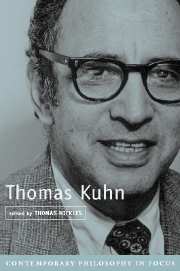Book contents
- Frontmatter
- Contents
- Contributors
- Preface
- Introduction
- 1 Kuhn and Logical Empiricism
- 2 Thomas Kuhn and French Philosophy of Science
- 3 Normal Science and Dogmatism, Paradigms and Progress: Kuhn ‘versus’ Popper and Lakatos
- 4 Kuhn's Philosophy of Scientific Practice
- 5 Thomas Kuhn and the Problem of Social Order in Science
- 6 Normal Science: From Logic to Case-Based and Model-Based Reasoning
- 7 Kuhn, Conceptual Change, and Cognitive Science
- 8 Kuhn on Concepts and Categorization
- 9 Kuhn's World Changes
- 10 Does The Structure of Scientific Revolutions Permit a Feminist Revolution in Science?
- Selected References in English
- Index
- References
1 - Kuhn and Logical Empiricism
Published online by Cambridge University Press: 07 December 2009
- Frontmatter
- Contents
- Contributors
- Preface
- Introduction
- 1 Kuhn and Logical Empiricism
- 2 Thomas Kuhn and French Philosophy of Science
- 3 Normal Science and Dogmatism, Paradigms and Progress: Kuhn ‘versus’ Popper and Lakatos
- 4 Kuhn's Philosophy of Scientific Practice
- 5 Thomas Kuhn and the Problem of Social Order in Science
- 6 Normal Science: From Logic to Case-Based and Model-Based Reasoning
- 7 Kuhn, Conceptual Change, and Cognitive Science
- 8 Kuhn on Concepts and Categorization
- 9 Kuhn's World Changes
- 10 Does The Structure of Scientific Revolutions Permit a Feminist Revolution in Science?
- Selected References in English
- Index
- References
Summary
Conventional wisdom concerning twentieth-century philosophical approaches to scientific knowledge has held that Kuhn's theory of scientific revolutions is diametrically opposed to the philosophical movement known as “logical positivism” or “logical empiricism.” Logical positivism has been portrayed as a naive version of empiricist foundationalism, according to which all knowledge is to be reduced to an epistemically certain basis in observational reports. And it follows, on this view, that there can be no genuine scientific revolutions in the Kuhnian sense: scientific progress must rather follow the “development-by-accumulation” model (in this case, development by accumulation of observable facts) that Kuhn explicitly rejects at the outset. If we accept Kuhn's theory, by contrast, it follows that the progress of science is marked by radical discontinuities quite incompatible with such naive empiricism. So it is no wonder that Kuhn's theory of scientific revolutions is standardly taken as a major factor in the demise of logical empiricism.
Over the past twenty-five years, however, a growing body of active research has been devoted to detailed study of the rise and decline of the logical empiricist movement. And this research has shown, not surprisingly, that the accepted conventional wisdom concerning the relationship between Kuhn's theory of scientific revolutions and logical empiricist philosophy of science is seriously oversimplified and fundamentally misleading. Perhaps the most striking results of this research appear in an article by George Reisch (1991) entitled “Did Kuhn Kill Logical Empiricism?
- Type
- Chapter
- Information
- Thomas Kuhn , pp. 19 - 44Publisher: Cambridge University PressPrint publication year: 2002
References
- 6
- Cited by

